#NASA Wallops
Text

On the 55th Anniversary of the Apollo 11 lunar landing, Austin and Agnes visited Joseph at Wallops Island, VA. Joseph is thrilled about reaching the halfway point of his SSAI-sponsored media internship at the Virginia Space Flight Academy’s Space Adventure Camp, capturing the excitement of the activities and trips of the summer camps’ fun-packed adventures on social media, making new friends, and literally opening the doors for the kids to portals of space, robotics, rocketry, and sports!
0 notes
Text
The D.C. area's no-flying-needed way to see a space launch
Tuesday night treated me to the first space launch I’d seen in person–meaning close enough to hear it–since 2018. And unlike the previous three launches that I have been privileged to experience from that close, this one did not require a flight to Florida.
Instead, only a three-hour drive lay between my house and Virginia Space’s Mid-Atlantic Regional Spaceport, hosted at NASA’s Wallops Flight…

View On WordPress
#Antares#Chincoteague#Eastern Shore#Electron#launch#launch viewing#liftoff#Mid-Atlantic Regional Spaceport#NASA Wallops#Northrop Grumman#Rocket Lab#Wallops Flight Facility#Wallops Island
0 notes
Text
- Tuesday, Jan 24, 2023 -
I haven't had time to be on here much so here's a quick update:
The spring semester started, this is now week 3 of classes! I'm retaking calc1 this semester since I didn't do too hot last semester, and I'm also taking an into computer science in C++ class, an observational astronomy class, and a philosophy class on human nature.
So far everything's good! I missed 3 CS assignments this weekend though so now my grade is sitting at a solid 29 T . T
My philosophy class is really interesting and engaging, so I'm actually thinking about a philosophy minor. Maybe a double minor in that and CS. Astrophysics uses a lotttt of computers these days so that will be Hella helpful to know.
Last week, I also had the pleasure of touring the flight facility at NASA Wallops with my school's chapter of the Society of Physics Students (which for ease's sake I will now be referring to as SPS), and it was so incredibly amazing!!!
Anyways, so far so good with everything; I'm already doing Way better in calc this time around, and my other classes are interesting too!
~☆~
I'm thinking I'll try to do a 100 days of productivity to keep myself on track and not let myself fall behind, so let this be day 1!
Today I am going to:
Finish my module 1 math homework
Read through the CS assigned text
Start studying for my chemistry clep


#college#study blog#studyblr#studying#stem students#uni#college student#spring#spring semester#new semester#back to school#society of physics students#sigma pi sigma#physics#space#nasa#nasa wallops#tour#100 days of productivity#100dop
0 notes
Text

Crews preparing the Mercury Launch Escape System and Boilerplate Mercury Capsule for the LJ-1 mission, for stacking atop of the Little Joe rocket.
Date: August 20, 1959
NASA ID: link
#Little Joe 1#LJ-1#Mercury Boilerplate#Boilerplate#Little Joe#Rocket#NASA#Mercury Program#Project Mercury#Mercury#Wallops LA-1#LA-1#Wallops Flight Facility#WFF#Wallops Island#Virginia#August#1959#my post
33 notes
·
View notes
Text
NRO Mission Launches from NASA Wallops on Electron Rocket
NASA’s Wallops Flight Facility supported the successful launch of a Rocket Lab Electron rocket at 3:25 a.m. EDT, Thursday, March 21, from Virginia’s Mid-Atlantic Regional Spaceport on Wallops Island, Virginia. The rocket carried three collaborative research missions for the National Reconnaissance Office (NRO). The mission, dubbed NROL-123, was the first NRO mission to fly on […]
from NASA https://ift.tt/Oo1Q6ci
2 notes
·
View notes
Video
undefined
tumblr
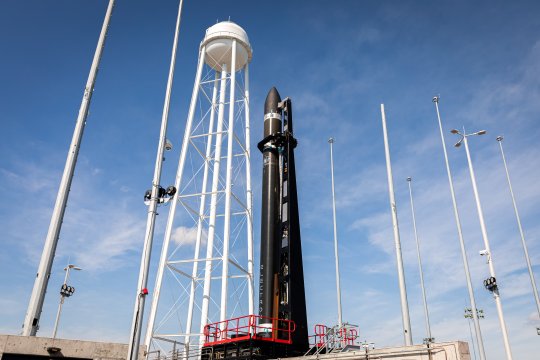


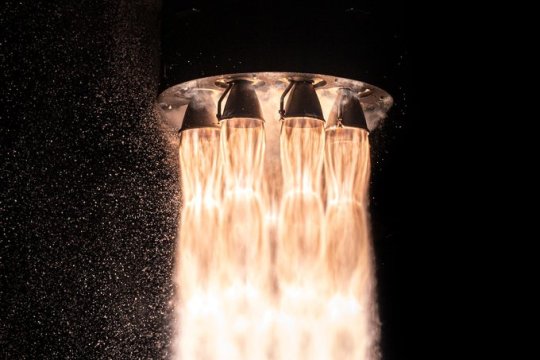

Rocket Lab Launches Electron Rocket from the US for the First Time
Rocket Lab, a prolific launch company that routinely blasts its towering Electron rockets out of New Zealand, conducted its first liftoff from US soil on Tuesday.
The mission, nicknamed “Virginia is for Launch Lovers,” took off from NASA’s Wallops Flight Facility on Virginia’s northern coast at 6 p.m. ET. The launch of the 60-foot (18.3-meter) rocket delivered three small satellites to orbit for the Earth-imaging company HawkEye 360, which uses a network of spacecraft to pinpoint radio frequencies on Earth in support of military and business projects.
Rocket Lab is among the most successful aerospace start-ups of the modern era. Unlike Elon Musk’s even more prolific rocket company, SpaceX, which builds larger rockets capable of hauling tens of thousands of pounds to orbit, Rocket Lab builds lightweight launch vehicles designed solely to lift small satellites — as compact as a loaf of bread or a refrigerator — to space.
Though the company has been headquartered in the United States since its inception, all of its prior launches have taken place at a pad near Ahuriri Point, located on the east coast of New Zealand’s North Island.
But Rocket Lab has sought for years to bring some of its launch operations stateside, in part so that it can provide services to the US government and military, which make up a lucrative slice of the global launch business customer base.
The NASA Wallops Flight Facility on Wallops Island in Virginia’s Accomack County is one of the oldest launch sites in the world. The first rocket flight took off from the site in 1945, before the creation of the space agency. More recently, the facility has been home to Northrop Grumman’s Antares rocket, which launches cargo resupply missions to the International Space Station.
By Jackie Wattles.
#Rocket Lab#Rocket Lab Launches Electron Rocket from the US for the First Time#Virginia is for Launch Lovers#Wallops Flight Facility#nasa#rocket#rocket launch#space#space mission
14 notes
·
View notes
Text
Penultimate Antares 230+ rocket lofts Cygnus spacecraft to ISS
Penultimate Antares 230+ rocket lofts Cygnus spacecraft to ISS
Antares launches with the NG-18 Cygnus cargo spacecraft bound for the International Space Station. Credit: Mark Usciak / Spaceflight Insider
Northrop Grumman’s Antares rocket disrupted a normally peaceful morning as it lifted off over the Atlantic from the Mid Atlantic Regional Spaceport at Wallops Island, Virginia, with the Cygnus NG-18 cargo mission to the International Space Station. (more…)

View On WordPress
3 notes
·
View notes
Text
ROCKETLAB ROCKET LIKE A HURRICANE
PRÓXIMA MISIÓN: COHETE COMO UN HURACÁN
Rocket Lab lanzará las observaciones de la estructura de la precipitación y la intensidad de la tormenta resueltas en el tiempo de la NASA con una misión Constellation of Smallsats (TROPICS) en dos lanzamientos separados de Electron.
DESCRIPCIÓN GENERAL DE LA MISIÓN
La primera misión, Rocket Like A Hurricane, será el lanzamiento número 36 de Electron de…

View On WordPress
#Ciencias y Tecnologías#CubeSat#Electron#Lanzamientos#NASA#Rocketlab#Satélite#sistema#Smallsats#Wallops
0 notes
Text
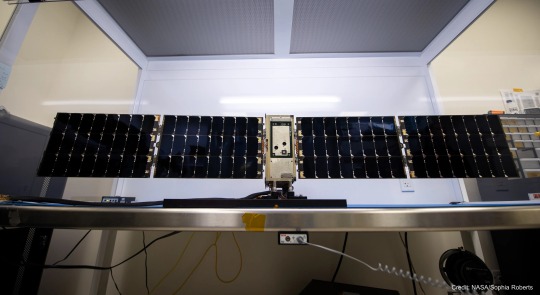
Tiny BurstCube's Tremendous Travelogue
Meet BurstCube! This shoebox-sized satellite is designed to study the most powerful explosions in the cosmos, called gamma-ray bursts. It detects gamma rays, the highest-energy form of light.
BurstCube may be small, but it had a huge journey to get to space.
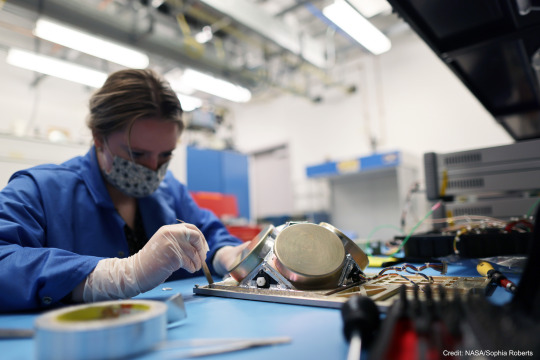
First, BurstCube was designed and built at NASA’s Goddard Space Flight Center in Greenbelt, Maryland. Here you can see Julie Cox, an early career engineer, working on BurstCube’s gamma-ray detecting instrument in the Small Satellite Lab at Goddard.
BurstCube is a type of spacecraft called a CubeSat. These tiny missions give early career engineers and scientists the chance to learn about mission development — as well as do cool science!
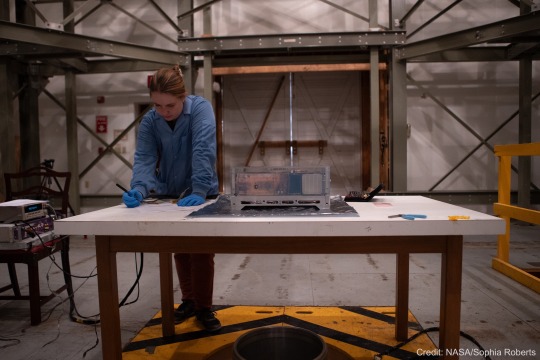
Then, after assembling the spacecraft, the BurstCube team took it on the road to conduct a bunch of tests to determine how it will operate in space. Here you can see another early career engineer, Kate Gasaway, working on BurstCube at NASA’s Wallops Flight Facility in Virginia.
She and other members of the team used a special facility there to map BurstCube’s magnetic field. This will help them know where the instrument is pointing when it’s in space.
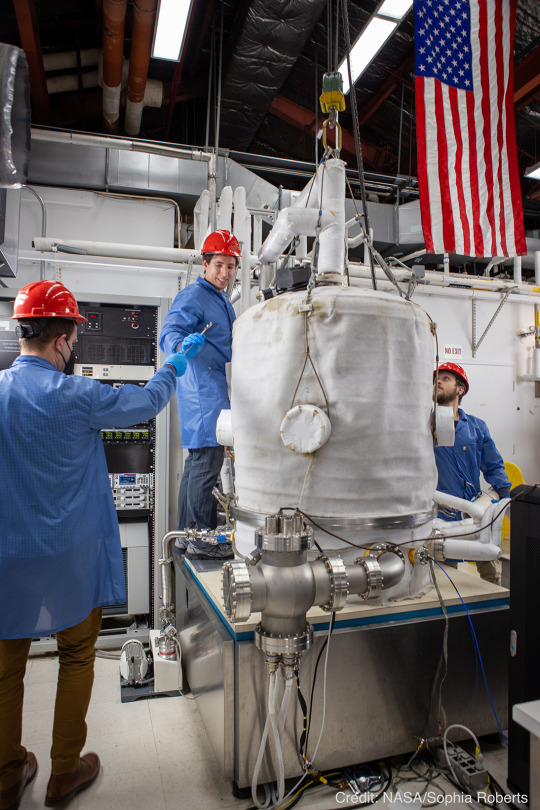
The next stop was back at Goddard, where the team put BurstCube in a vacuum chamber. You can see engineers Franklin Robinson, Elliot Schwartz, and Colton Cohill lowering the lid here. They changed the temperature inside so it was very hot and then very cold. This mimics the conditions BurstCube will experience in space as it orbits in and out of sunlight.
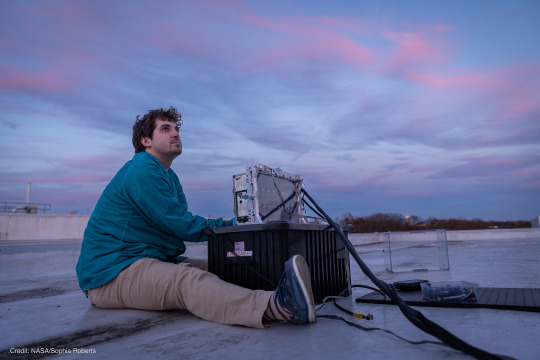
Then, up on a Goddard rooftop, the team — including early career engineer Justin Clavette — tested BurstCube’s GPS. This so-called open-sky test helps ensure the team can locate the satellite once it’s in orbit.
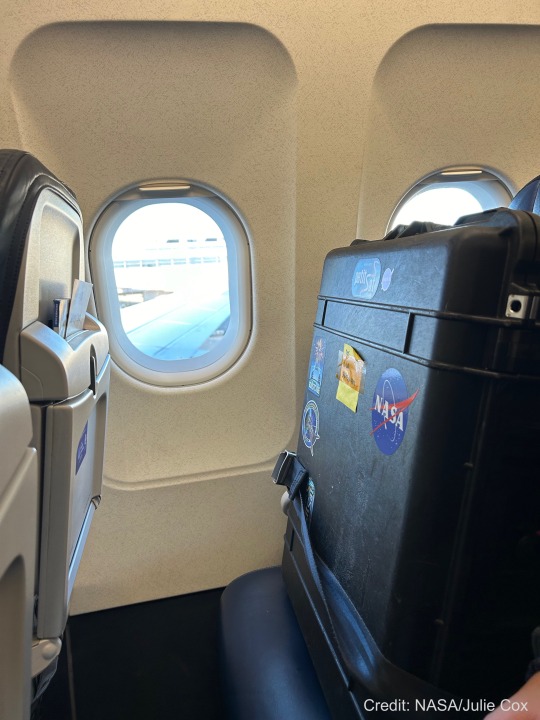
The next big step in BurstCube’s journey was a flight to Houston! The team packed it up in a special case and took it to the airport. Of course, BurstCube got the window seat!

Once in Texas, the BurstCube team joined their partners at Nanoracks (part of Voyager Space) to get their tiny spacecraft ready for launch. They loaded the satellite into a rectangular frame called a deployer, along with another small satellite called SNoOPI (Signals of Opportunity P-band Investigation). The deployer is used to push spacecraft into orbit from the International Space Station.
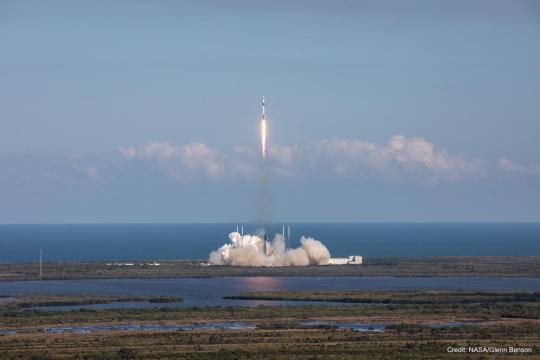
From Houston, BurstCube traveled to Cape Canaveral Space Force Station in Florida, where it launched on SpaceX’s 30th commercial resupply servicing mission on March 21, 2024. BurstCube traveled to the station along with some other small satellites, science experiments, as well as a supply of fresh fruit and coffee for the astronauts.
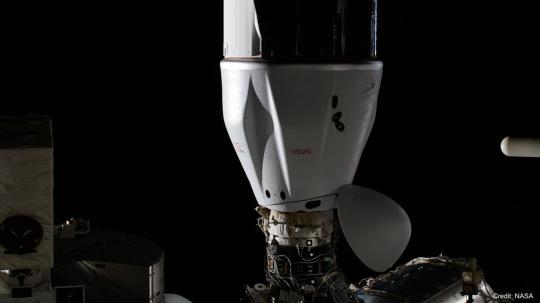
A few days later, the mission docked at the space station, and the astronauts aboard began unloading all the supplies, including BurstCube!
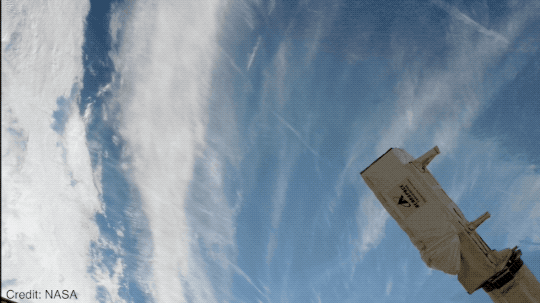
And finally, on April 18, 2024, BurstCube was released into orbit. The team will spend a month getting the satellite ready to search the skies for gamma-ray bursts. Then finally, after a long journey, this tiny satellite can embark on its big mission!
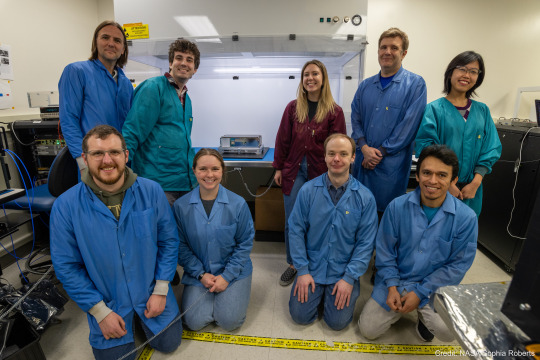
BurstCube wouldn’t be the spacecraft it is today without the input of many early career engineers and scientists. Are you interested in learning more about how you can participate in a mission like this one? There are opportunities for students in middle and high school as well as college!
Keep up on BurstCube’s journey with NASA Universe on X and Facebook. And make sure to follow us on Tumblr for your regular dose of space!
#tech#technology#dream job#jobseekers#NASA#space#spaceblr#universe#astronomy#science#gamma ray bursts#cubesat#smallsat#launch
653 notes
·
View notes
Text

Little Joe 1 on the launch pad at the Wallops Flight Facility in Virginia. August 21, 1959.
Little Joe 1 was meant to test the launch escape system for the Mercury spacecraft during a Max Q abort, when the spacecraft would be encountering the most stress during a launch. The launch escape system fired prematurely, 30 minutes before the scheduled launch of Little Joe 1. The cause was linked to an electrical fault in a coil designed to protect biological specimens from a rapid abort.
NASA
NASA SP-4201, p. 208
2 notes
·
View notes
Link
The NASA Aircraft Management Advisory Board (AMAB), which manages the agency’s aircraft fleet, has decided to relocate the agency’s P-3 aircraft at Wallops to Langley Research Center. The decision is part of a long-running, NASA-wide aircraft enterprise-management activity to consolidate the aircraft fleet where feasible and achieve greater operational efficiencies while reducing our infrastructure footprint. We all recognize this is a tough decision impacting a stellar, mission-focused team that has achieved so much over the years. I myself started my career in the Wallops Aircraft Office some 38 years ago, and my time there was foundational for all I’ve done in my career. My top priority is to work with the Aircraft Office team on a transition plan, and importantly, to carry out an effective and safe transition of the aircraft to NASA Langley, and to ensure the long term sustainability of NASA’s P-3 capability in support of the airborne science community. The Wallops aircraft office transition may take 18 to 24 months or more to accomplish. A specialized team is forming to ensure a smooth transition, and in the meantime, we continue to support airborne science from the facility. With NASA’s flying mission at Wallops relocating to Langley, we recognize that the hangars and airfield at Wallops are true regional assets with great potential. NASA will issue a request for information (RFI) to identify potential customers/interest in assuming responsibility for Wallops’ airfield operations. It’s in the best interest of NASA and the region to explore other uses and opportunities for the Wallops airfield, and this RFI will help NASA evaluate future options. There is no timeline for the RFI at this time – we will provide updates as more information becomes available. What we do know – and are fully committed to – is ensuring the airfield remains an important resource for continued use by our customers, such as the U.S. Navy’s Fleet Force Command Field Carrier Landing Practice program. We’ve supported Navy flight operations at Wallops for more than 10 years and that support continues. I want to assure everyone that Wallops’ future is bright and secure – the facility has a diverse mission set of orbital and suborbital operations and a whole host of government and commercial customers expanding operations on-site. We expect Wallops’ launch cadence to increase to upward of 50 launches per year by 2030 as the facility takes on a growing portfolio of hypersonics work as well as support to commercial spaceflight. Without a doubt, the Wallops Aircraft Team is the best in the agency. They’ve had a massively successful run of operations recently with the ARCSIX missions in Greenland to supporting student research flights on both coasts and cargo transport missions all over the world to places such as Antarctica and India. I am committed to working with every member of the team on a way forward as we transition our flight operations and seek new opportunities. We will continue to communicate with you and provide information on the transition plans as they become available. All the best, Dave David L. PierceWallops Director
2 notes
·
View notes
Text

My son Joseph is over the moon since, through SSAI, he will serve as Media Intern at the Virginia Space Flight Academy’s Space Adventure Camp at NASA's Wallops Flight Facility, Wallops Island, VA starting Saturday, July 6, 2024. The Space Adventure Camp is a residential camp experience on aerospace, coding and robotics for kids 11-16 years of age. Congratulations, Joseph! Thank you, SSAI!
0 notes
Text
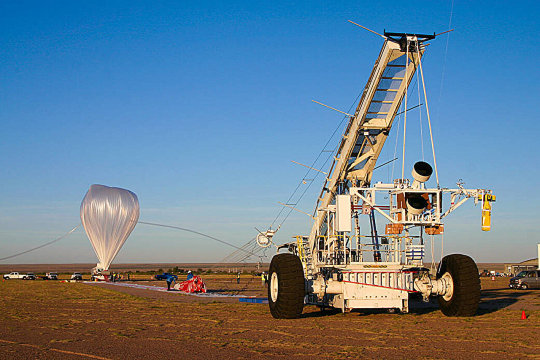
NASA to launch 8 scientific balloons from New Mexico
NASA's Scientific Balloon Program has kicked off its annual fall balloon campaign at the agency's balloon launch facility in Fort Sumner, New Mexico. Eight balloon flights carrying scientific experiments and technology demonstrations are scheduled to launch from mid-August through mid-October.
The flights will support 16 missions, including investigations in the fields of astrophysics, heliophysics, and atmospheric research.
"The annual Fort Sumner campaign is the cornerstone of the NASA Balloon Program operations," said Andrew Hamilton, acting chief of NASA's Balloon Program Office.
"Not only are we launching a large number of missions, but these flights set the foundation for follow-on missions from our long-duration launch facilities in Antarctica, New Zealand, and Sweden. The Fort Sumner campaign is also a strong focus for our student-based payloads and is an excellent training opportunity for our up-and-coming scientists and engineers."
Returning to the fall lineup is the EXCITE (Exoplanet Climate Infrared Telescope) mission led by Peter Nagler, principal investigator, NASA's Goddard Space Flight Center in Greenbelt, Maryland. EXCITE features an astronomical telescope developed to study the atmospheric properties of Jupiter-type exoplanets from near space. EXCITE's launch was delayed during the 2023 campaign due to weather conditions.
"The whole EXCITE team is looking forward to our upcoming field campaign and launch opportunity from Fort Sumner," said Nagler. "We're bringing a more capable instrument than we did last year and are excited to prove EXCITE from North America before we bring it to the Antarctic for our future long-duration science flight."
Some additional missions scheduled to launch include:
Salter Test Flight: The test flight aims to verify system design and support several smaller payloads on the flight called piggyback missions.
HASP 1.0 (High-Altitude Student Platform): This platform supports up to 12 student payloads and assists in training the next generation of aerospace scientists and engineers. It is designed to flight test compact satellites, prototypes, and other small payloads.
HASP 2.0 (High-Altitude Student Platform 2): This engineering test flight of the upgraded gondola and systems for the HASP program aims to double the carrying capability of student payloads.
DR-TES (mini-Dilution Refrigerator and a Transition Edge Sensor): This flight will test a cooling system and a gamma-ray detector in a near-space environment.
TIM Test Flight (Terahertz Intensity Mapper): This experiment will study galaxy evolution and the history of cosmic star formation.
THAI-SPICE (Testbed for High-Acuity Imaging—Stable Photometry and Image-motion Compensation Experiment): The goal of this project is to build and demonstrate a fine-pointing system for stratospheric payloads with balloon-borne telescopes.
TinMan (Thermalized Neutron Measurement Experiment): This hand-launch mission features a 60-pound payload designed to help better understand how thermal neutrons may affect aircraft electronics.
An additional eight piggyback missions will ride along on flights to support science and technology development. Three of these piggyback missions are technology demonstrations led by the balloon program team at NASA's Wallops Flight Facility in Virginia. Their common goal is to enhance the capabilities of NASA balloon missions.
CASBa (Comprehensive Avionics System for Balloons) aims to upgrade the flight control systems for NASA balloon missions. DINGO (Dynamics INstrumentation for GOndolas) and SPARROW-5 (Sensor Package for Attitude, Rotation, and Relative Observable Winds—Five) are technology maturation projects designed to provide new sensing capabilities for NASA balloon missions.
Zero-pressure balloons, used in this campaign, are in thermal equilibrium with their surroundings as they fly. They maintain a zero-pressure differential with ducts that allow gas to escape to prevent an increase in pressure from inside the balloons as they rise above Earth's surface.
This zero-pressure design makes the balloons very robust and well-suited for short, domestic flights, such as those in this campaign. The loss of lift gas during the day-to-night cycle affects the balloon's altitude after repeated day-to-night cycles; however, this can be overcome by launching from the polar regions, such as Sweden or Antarctica, where the sun does not set on the balloon in the summer.
To follow the missions in the 2024 Fort Sumner fall campaign, visit NASA's Columbia Scientific Balloon Facility website for real-time updates of balloons' altitudes and locations during flight.
3 notes
·
View notes
Text
Virginia Gov. Glenn Youngkin will announce Thursday that his state has surpassed a business-creation milestone he made a campaign pledge to meet.
After he was declared the victor in November 2021 against Democratic former Gov. Terence McAuliffe, Youngkin, a Republican, pledged to foster 10,000 new start-up businesses during his term.
"On day one, we’re going to jumpstart our jobs and reinvigorate the economy so it lifts up all Virginians," Youngkin said at the time, having repeatedly declared since that "Virginia is open for business."
On Thursday, Youngkin said he achieved that goal in "record time."
"Through our ‘Compete to Win’ strategy, we’ve reached this incredible milestone by driving innovation, fostering entrepreneurship, bolstering our talent pipeline, providing needed tax relief, and truly creating an environment where startups and businesses can thrive," he said.
"Our efforts to bolster our business environment over the past two and a half years have earned Virginia the top state for business accolade. All startups should come to Virginia because we are fostering an environment of success."
Youngkin will visit ZEBOX in Arlington later Thursday to commemorate the milestone. ZEBOX is a "startup accelerator" and "innovation hub," the governor’s office said in a statement.
In response, Virginia Secretary of Commerce Caren Merrick said it is exciting to see so many innovators and entrepreneurs choose Virginia to launch their projects.
"I look forward to thousands more in the future," Merrick said.
With Virginia being the rare state in which governors cannot be sequentially re-elected, that left the Falls Church businessman with only four years to meet the goal.
Youngkin said he is also proud to see CNBC name Virginia the top state for business in the country.
One recent ribbon-cutting took place not far from the governor’s office, as Youngkin joined Petersburg Mayor Sam Parham to open the Petersburg Pharma Campus, which houses several pharmaceutical manufacturers.
On the other side of the state, Firefly Aerospace chose Virginia Spaceport Authority’s Wallops Island facility near Accomac earlier this summer as the launchpad for its Alpha launch vehicle. Wallops Island is also home to an active NASA site.
As early as 2022, Youngkin’s name was being floated as a potential Republican presidential candidate, though the governor has repeatedly stressed his focus remains on Virginia rather than any national political aspirations.
"They elected me to lead change. They elected me to lead Virginia forward. And that's what we're doing," Youngkin told Fox News at the time.
Until Sen. JD Vance, R-Ohio, was ultimately selected by former President Trump, the political newcomer had also been floated as a potential vice presidential nominee.
Prior to venturing into politics, Youngkin himself had a successful career in the business sector, helming an executive position with the private equity firm Carlyle Group since 1995.
During his tenure there, he reportedly helped Carlyle lead a high-profile $12 billion revamp of John F. Kennedy International Airport’s Terminal 1.
4 notes
·
View notes
Text
Update on NASA Wallops Aircraft and Airfield Operations
The NASA Aircraft Management Advisory Board (AMAB), which manages the agency’s aircraft fleet, has decided to relocate the agency’s P-3 aircraft at Wallops to Langley Research Center. The decision is part of a long-running, NASA-wide aircraft enterprise-management activity to consolidate the aircraft fleet where feasible and achieve greater operational efficiencies while reducing our infrastructure footprint. […]
from NASA https://ift.tt/lgCdFhp
0 notes
Text
NG-18 Cygnus cargo ship to launch new science to ISS
NG-18 Cygnus cargo ship to launch new science to ISS
The Antares rocket with the NG-18 Cygnus spacecraft stands ready for launch at Wallops Island, Virginia. Credit: Steve Hammer / Spaceflight Insider
Northrop Grumman and NASA are set to fly the NG-18 Cygnus spacecraft to the International Space Station from Wallops Island, Virginia. (more…)

View On WordPress
2 notes
·
View notes